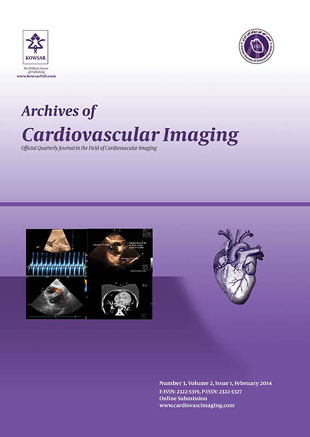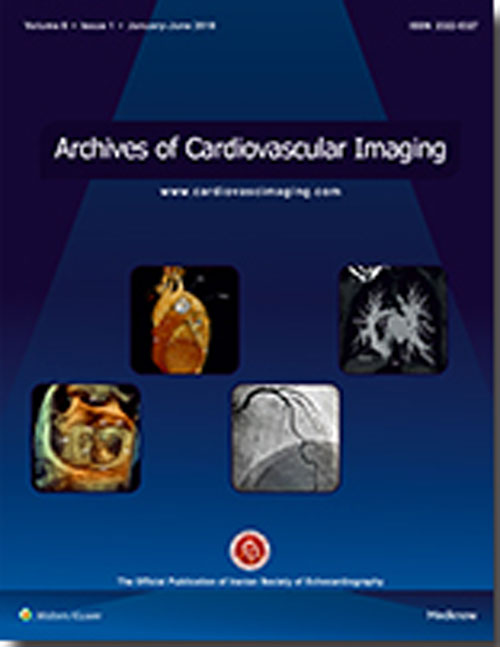فهرست مطالب

Archives Of Cardiovascular Imaging
Volume:2 Issue: 1, Feb 2014
- تاریخ انتشار: 1392/11/25
- تعداد عناوین: 12
-
Page 13737BackgroundPulmonary artery hypertension is the presentation of various types of cardiovascular and systematic diseases. There are different kinds of noninvasive methods to determine right ventricular function, pulmonary artery pressure, and effect of pulmonary hypertension on right ventricular function. These methods include the tissue Doppler imaging (TDI) of the tricuspid annulus and the longitudinal deformation indices of the right ventricular free wall..ObjectivesIn some patients, the echocardiogram cannot help estimate pulmonary artery pressure. In this study, we evaluated the effect of pulmonary hypertension on the TDI of the tricuspid annulus and the longitudinal strain and strain rate of the basal segment of the right ventricular free wall in patients with left-sided valvular heart disease and pulmonary hypertension. Indeed, we sought to investigate whether we can guess the presence of pulmonary hypertension through the measurement of the TDI of the tricuspid annulus and the deformity indices of the basal segment of the right ventricular free wall..Patients andMethodsEighty consecutive patients with left-sided valvular disease and pulmonary artery hypertension (V/PH Group) and 80 healthy matched controls (H Group) were enrolled in this research. The TDI parameters were obtained in the tissue velocity imaging mode during systole (S, S VTI), early relaxation (E), atrial systole (A), and isovolemic relaxation time (IVRT). The deformation indices included peak systolic longitudinal strain and strain rate measured from the basal segment of the right ventricular free wall and were calculated as the relative magnitude of segmental deformation..ResultsS, E, and S VTI were reduced significantly in the V/PH Group, and there was a significant negative correlation between S velocity, S VTI with pulmonary artery systolic pressure (PASP), and right ventricular diameter (RVD). According to the ROC curve, S velocity 10.5 cm/s had 65% sensitivity and 40% specificity for the prediction of pulmonary hypertension. E velocity had only a negative significant correlation with RVD and no significant correlation with tricuspid annular plane systolic excursion (TAPSE) and PASP. There was no significant difference in A velocity and E/A ratio between the two groups (P = 0.455 and P = 0.070, respectively), and these parameters had no significant correlation with RVD and TAPSE. IVRT was significantly increased in the V/PH Group versus the H Group, and IVRT > 40 ms had 78% sensitivity and 67% specificity for the prediction of pulmonary hypertension. In comparison with the H Group, RV longitudinal peak systolic strain (-14/35 ± 4%) and strain rate (-0.65 ± 0.12) at the basal segment of the right ventricular free wall were significantly lower in the V/PH Group (P < 0.001 and P < 0.001)..ConclusionsWe observed a significant reduction in S, E velocity, and S VTI of the tricuspid annulus. Moreover, the strain/strain rate of the basal segment of the right ventricular free wall had a marked decrease in the V/PH Group in comparison with the healthy subjects..Keywords: Hypertension, Lung, Heart Ventricles, Tricuspid Valve, Elasticity Imaging Techniques, Sprains, Strains
-
Page 14534BackgroundObstructive sleep apnea (OSA) is a common sleep disease. It is associated not only with hypertension but also with other cardiac complications. Thus, the early detection of cardiac disorders is very useful..ObjectivesWe sought to evaluate different echocardiographic parameters..Patients andMethodsThis cross-sectional study was done on 55 patients with OSA. The patients were divided into three groups: mild, moderate, and severe according to the apnea hypopnea index (AHI) and all underwent echocardiography. Analysis was done by SPSS 18 as well as the chi-squared and one-way ANOVA tests..ResultsThe mean age of the study population was 51.16 ± 12.88 years old and 36 (65.5%) patients were male. Right Tei index mean was 0.383 ± 0.213, which was abnormal in 19.1% of the patients. Left Tei index mean was 0.378 ± 0.230 and was abnormal in 52.9% of the patients. Pulmonary artery pressure mean was 18.32 ± 8.91 and was normal in 39 (70.9%) patients. Only basal septum strain (P = 0.015) and basal septum strain rate (P = 0.005) changes were associated with OSA severity..ConclusionsThe main findings of this study were relative left ventricular systolic and diastolic dysfunction as well as dysfunction in some parameters of the right ventricle. The prevalence of these disorders and what constitutes the best echocardiographic parameter for their diagnosis are controversial and require further research..Keywords: Obstructive Sleep Apnea, Echocardiography, Cardiovascular Diseases
-
Page 14557IntroductionTuberculosis (TB) is a serious disease in developing countries. Tuberculous pericarditis is a rare but life-threatening condition and may lead to cardiac tamponade and constrictive pericarditis..Case PresentationAn 82-year-old man was referred for cardiac consultation. He was suffering from dyspnea, malaise, weight loss, night sweat, and fever for four months duration..DiscussionTransthoracic echocardiography disclosed massive pericardial effusion, respiratory variation in mitral and tricuspid inflow E velocity, increased diastolic flow reversal with expiration in the hepatic vein, septum deviation in inspiration toward the left ventricle (LV), preserved LV function, and inferior vena caval (IVC) dilation without any collapse in inspiration. Chest computed tomography (CT) revealed a large amount of pericardial effusion and bilateral pleural effusion..Keywords: Mycobacterium Tuberculosis, Pericarditis, Caseating Necrosis
-
Page 15633IntroductionLeft atrial thrombi are present in one third of patients with severe rheumatic mitral stenosis and atrial fibrillation. A left atrial mass can be diagnosed as a thrombus by transthoracic echocardiography in the presence of the predisposing factors for a thrombus such as mitral stenosis and atrial fibrillation. The sensitivity of transthoracic echocardiography for detecting left atrial appendage thrombi is low, and only a few case reports have been described in the literature..Case PresentationThis report describes the case of a 65-year-old female with severe rheumatic mitral stenosis and chronic atrial fibrillation presenting with congestive heart failure. This patient was shown, by means of transthoracic echocardiography, to have a large immobile left atrium cavity mass (6.5 × 3.4 × 2.3 cm) and a large left atrial appendage mass (1.7 cm) identified as a thrombus. Contrast computed tomography of the chest confirmed the diagnosis..ConclusionsTransthoracic echocardiography was sufficient to establish the diagnosis and to decide its management..Keywords: Atrial Function, Left Atrial Appendage, Thrombosis, Echocardiography
-
Page 16081BackgroundPatients with hypertension are at risk of structural and functional changes in the left atrium (LA). There are only a few studies on the impact of hypertension on LA function, especially in hypertensive patients with a normal LA size. We, therefore, designed this study to evaluate LA function in patients with a normal LA size via deformation imaging..ObjectivesWe assessed regional longitudinal strain rate imaging (SRI) profiles along with tissue velocity imaging (TVI) in the LA walls to quantify LA reservoir function and explore changes in LA function in hypertensive patients with a normal value of LA size..Patients andMethodsOne hundred twenty-four subjects with normal angiography (mean age = 56.28 ± 8.91 years, 46% male), who were referred to the Echocardiography Laboratory of our institution, were enrolled in this study. These subjects were categorized into two groups: hypertensive (75 cases) and age-matched normotensive (49 cases) groups. All the cases of the patient and control groups had a normal LA size. SRI parameters included strain (ST, %) and strain rate (SR, s-1), and tissue imaging parameters such as peak systolic velocity (Sm, m/s) were measured in four septal, lateral, anterior, and inferior LA walls at the mid-level..ResultsCompared with the controls, the patients with a history of hypertension showed significantly lower values of Sm, ST, and SR in each segment of the LA. There was no effect of age on these indices. Also, no differences regarding Sm, ST, and SR were found between the septal, lateral, anterior, and inferior LA walls in each group. By multivariate linear regression analysis, a history of hypertension was the only independent determinant of average LA strain rate in the all the individuals (P < 0.001). When this analysis was repeated in the patients with a history of hypertension, the only independent determinant of average LA strain rate was heart rate (P = 0.026)..ConclusionsIn our subjects, with a normal value of LA size, the effect of hypertension on LA reservoir function was independent of age, sex, heart rate, left ventricular mass index, and left ventricular ejection fraction. Additionally, heart rate independently correlated with reduced TVI and SRI parameters in the patients with hypertension..Keywords: Heart Atria, Echocardiography, Hypertension
-
Page 17123BackgroundMitral valve prolapse (MVP) is allied to a variety of echocardiographic and pathologic findings, not least courtesy of the advent of novel and stringent echocardiographic criteria. MVP enjoys definite and clear-cut characteristics and is, as such, a fertile ground for research. Tissue Doppler imaging (TDI) is a relatively new imaging technique, and there is currently a dearth of information on this modality in patients with MVP syndrome..ObjectivesWe aimed to evaluate the findings of TDI in MVP syndrome..Patients andMethodsSeventy-five patients with MVP syndrome and 50 normal individuals as the control group were evaluated. The general characteristics and echocardiographic findings, especially TDI results, were evaluated and compared between the two groups. Mitral annular TDI velocities (Sm, Em, and Am) were measured at the lateral corner of the MV in the apical four-chamber view of transthoracic echocardiography..ResultsSeventy-five patients (48 females) at a mean age of 26.5 ± 9.4 years and 50 individuals (32 females) at a mean age of 27.1 ± 8.3 years were enrolled in the study. As the important results of our study, Sm wave was much more prominent and much higher in the MVP group (P = 0.00); Em was lower (P = 0.00) and Am was slightly higher (P = 0.12). Furthermore, the E waves of MV inflow for the MVP and control groups were similar and E/Em was significantly higher in the MVP group (P = 0.00); taken together with a higher left atrial volume in this group, this finding revealed a relatively higher left ventricular end-diastolic pressure..ConclusionsSm wave in TDI is prominent and significantly high in MVP syndrome. Also, our study showed some degree of diastolic dysfunction in MVP patients.Keywords: Mitral Valve Prolapse, Echocardiography, Elasticity Imaging Techniques, S wave
-
Page 17300


